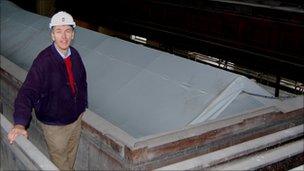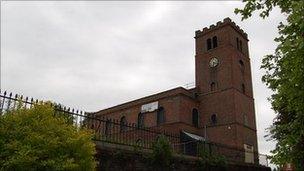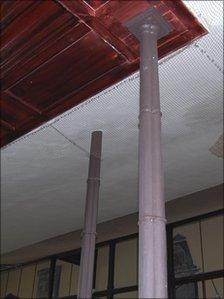St James Church in Liverpool reopens after 40 years
- Published

The Reverend Neil Short is re-establishing St James as a parish church
A Liverpool church is enjoying a new lease of life after reopening following almost four decades of closure.
St James, an Anglican church built in 1775, had been closed since the 1970s.
The Diocese of Liverpool is using the building to establish a new city centre church led by the Reverend Neil Short.
The congregation of St James in the City now number about 50 who currently worship in two tents that have been put up inside the building due to the disrepair of the roof.
"We were starting a new contemporary church targeting students and young professionals," Mr Short said.
"We started with just my wife and I, we met in our house until the numbers got to about 15, then we moved into a room in the cathedral for another year.
"In the third year we moved into a small tent inside the church."
City living
St James closed in the mid 1970s. Redevelopment of local streets had led to many residents leaving and a planned inner city ring road was set to cut the church off from much of the area.
The road was never built and in recent years the trend for city living and the restoration of houses around Upper Parliament Street has brought people back into the southern city area.
St James was, until recently, in the hands of the Churches Conservation Trust, a national charity that cares for historic churches that are no longer in use.
St James was returned to the Diocese of Liverpool in 2010.
"I think it's the first church that has gone into the hands of the Churches Conservation Trust and come out again into use," Mr Short said.
"Churches often go in cycles. If you take this church in 1860 the records show that there were about 10 people coming, that the windows were broken and the gas had been turned off because they couldn't pay the bill."

St James is in an area that has changed considerably in recent years
Mr Short chose to reopen St James rather than find another venue due to the potential of the site.
"If you look at St James there's lots of good things. It's at a major junction, two major roads, Upper Parliament Street and St James Place," he said.
"It's on an elevated site, it's got lots of room for development and it's got ample car parking space.
"If we'd moved a bit further into the city centre none of these things would have been possible, to buy a site would have cost an absolute fortune."
Cast iron structure
St James was built on what was then the outskirts of the town of Liverpool. Many of the merchants who contributed to its cost were slave traders.
The Grade II listed building is thought to be the oldest example of a cast iron structure in the UK.
"The columns for the church which hold the balcony up are made of cast iron and I'm told by English Heritage that these are the oldest surviving cast iron columns anywhere in the country," Mr Short said.
"The significance of them is that prior to that there would have been really thick stone columns, and it's this technology which was used to build the docks and warehouses, so it's all part of the history of Liverpool and why Liverpool became such a driving force in the Empire."
After decades out of use, the interior is stripped of pews and the roof is in need of replacement, meaning the congregation use small marquees inside.

Cast iron pillars inside the Grade II listed church, built in 1775
"We put tents up to keep the water off, but mainly so we can heat a smaller area," Mr Short said.
"There's no heating system in the church so we've installed some oil filled radiators.
"Churches are big buildings, they're big money and this is a top two star listed building, so we've had experts to evaluate the situation and they reckon to renew the roof will cost around £500,000.
"We hope to be able to replace the roof starting in October or November and it should take about six months."
Mr Short is now working with the Diocese of Liverpool on plans to use surrounding land to create new community facilities.
"We're not just wanting to restore this old building," Mr Short said.
"We're wanting to use this building to help to regenerate this community.
"We're talking to the council about using some derelict pieces of land which are around the church for community facilities and start up homes, we'd particularly like to do a respite care centre."
- Published18 May 2011
- Published12 April 2011
- Published18 March 2011